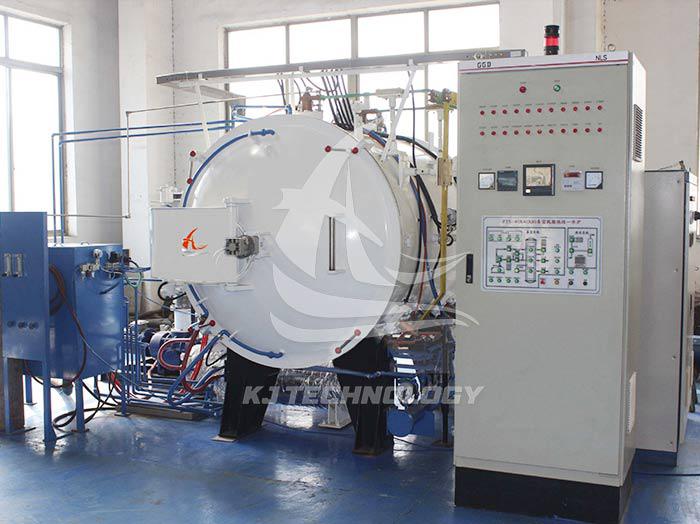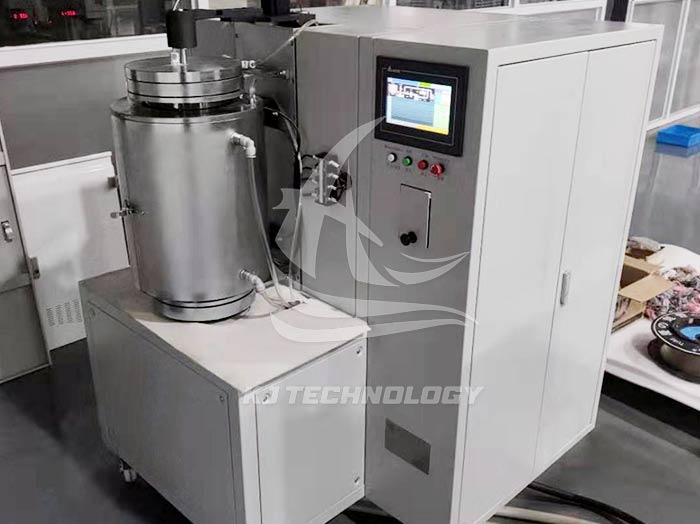Experimental vacuum hot pressing furnace for hot pressing hard alloys
 09-22-2025 Author: KJ technology
09-22-2025 Author: KJ technology
The experimental vacuum hot pressing furnace has unique process advantages in hot pressing hard alloys. Through the synergistic effect of vacuum environment, high-temperature heating, and mechanical pressure, the density and performance of hard alloys can be significantly improved. The core process characteristics and operating points are as follows:
1. Process characteristics
High density and low porosity
The density of the hot pressed product is close to the theoretical value, and the porosity is extremely low. For example, tungsten carbide cobalt (WC Co) hard alloy has high density and lower porosity through hot pressing sintering.
Fine grain structure
The hot pressing time is short (usually 10-60 minutes), which inhibits the growth of carbide grains.
Ability to form complex shapes
Powder materials have thermoplasticity during the hot pressing process and can be made into shaped products such as thin-walled tubes and spherical columns. For example, a thin-walled tube with a diameter of 50 mm and a wall thickness of 2 mm can be formed by hot pressing once, while the cold pressing process requires multiple processing.
Preparation of large-sized products
The unit pressure of hot pressing is only 1/10 of that of cold pressing, and it can produce large-scale products. For example, hard alloy rollers produced by hot pressing can weigh hundreds of kilograms and have higher dimensional accuracy.
Inhibit oxidation and impurity pollution
A vacuum environment (maximum vacuum degree ≤ 6.7 × 10 ⁻ ³ Pa) can eliminate gas impurities and prevent cobalt phase oxidation.
2. Key process parameters
temperature control
Defatting stage: Slowly raise the temperature to 500 ℃ and hold for 30-60 minutes to allow the molding agent (such as paraffin) to completely evaporate.
Intermediate stage: Rising to 1350 ℃ at a rate of 10 ℃/minute, cobalt begins to melt and infiltrate WC particles.
Final sintering: Maintain temperature and pressure at 1400-1450 ℃, with a pressure of 30-50 MPa, and fill the gaps with liquid cobalt. The insulation time is calculated based on the thickness of the workpiece.
pressure control
Pre pressing: Apply 20-30 MPa pressure after mold installation to ensure the strength of the green body.
Main pressure: During the sintering stage, the pressure gradually increases to 30-50 MPa, and the holding time is adjusted according to the material thickness.
cooling rate
Segmented cooling: Maintain a slow cooling rate of 5 ℃/minute from the sintering temperature to 1000 ℃ to prevent thermal stress cracking; Below 1000 ℃, it can be accelerated to 10 ℃/minute.
Inflation timing: The vacuum environment should be maintained below 800 ℃ before argon gas can be injected. Premature inflation can lead to surface oxidation.
3. Typical equipment parameters
Taking the experimental vacuum hot press furnace (such as VVPgr-40-1600 type) as an example:
Effective heating zone: Φ 160 × 160 mm
Maximum temperature: 1600 ℃ (graphite heating)
Ultimate vacuum degree: 6.7 × 10 ⁻ ³ Pa
Mechanical pressure: 20 tons (customizable from 0-40 tons)
Temperature uniformity: ± 5 ℃ (at 1600 ℃)
Pressure rise rate: ≤ 0.67 Pa/h
Control mode: PLC+touch screen, supporting multi-stage program heating and automatic pressure adjustment.
4 .Application Cases
Precision rolling mill manufacturing
WC-6% Co powder was used to prepare rolling rolls through vacuum hot pressing sintering, with a density of 14.9 g/cm ³, a hardness of HRA 92.5, and higher wear resistance than atmospheric pressure sintering.
Tool brazing
The hard alloy blade and steel substrate are brazed by vacuum hot pressing, and the joint strength is high, far higher than flame brazing.
Forming of irregular parts
By using isostatic pressing assisted molding and vacuum hot pressing, a complex tubular component with a diameter of 200 mm and a wall thickness of 5 mm was prepared, exhibiting excellent density uniformity.
5. Operation precautions
Powder pretreatment: WC particle size is controlled within 0.5-3 μ m, cobalt content is controllable, and the proportion of molding agent is within the set range.
Mold design: Graphite mold is used, with boron nitride coating on the inner wall to prevent adhesion, and powder is evenly filled in layers.
Quality inspection:
Density measurement: Archimedes drainage method, qualified products have a density higher than the theoretical value.
Metallographic observation: WC grains have a uniform polygonal shape, and cobalt phase is continuously distributed without aggregation.
Safety regulations:
Check the emergency water cooling system monthly to ensure that cooling is started within 3 minutes in case of power outage.
Install explosion-proof film on the vacuum furnace body, and set the burst pressure at the set value.








